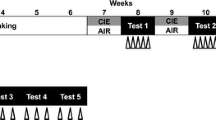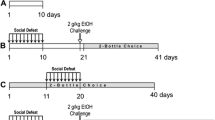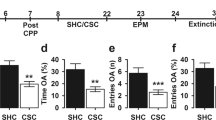Abstract
Rationale
Swim test susceptible (SUS) rats selectively bred for reduced struggling in the forced swim test (FST) following stress show high voluntary ethanol intake like alcohol-preferring (P) rats selectively bred for ethanol preference. It is unknown whether stress enhances drinking in SUS rats or FST behavior in P and non-preferring (NP) rats.
Objectives
The aim of this study was to assess the response to stress in male SUS, Sprague-Dawley (SD), P, and NP rats on 10% ethanol drinking and FST behavior.
Methods
In experiment 1, SUS and SD rats had limited access to ethanol and water following white noise, rehousing, and forced swim stress. In experiment 2, P and NP rats received footshock, white noise, restraint, or no stress prior to the FST. Rats then had continuous access to ethanol and water, and the effects of weekly exposures to stress were measured.
Results
SUS rats drank more ethanol (M = 2.98 g/kg) than SD rats (M = 1.26 g/kg) at baseline. Stress produced sustained increases (~33% of baseline) in ethanol intake in SUS rats. NP rats spent twice as much time immobile as P rats in the FST. Stress did not alter FST behavior in P or NP rats. Only footshock produced an increase (~29%) in ethanol intake in P rats.
Conclusions
Selection for stress-induced depressive-like behavior in SUS rats is associated with enhanced stress-induced ethanol drinking. However, the selection for alcohol preference is not associated with stress-induced depressive-like behavior but is associated with footshock stress-induced ethanol drinking. In these experiments, relationships among stress, depressive-like behavior, and alcohol preference were not symmetrical.




Similar content being viewed by others
References
Bell RL, Rodd ZA, Sable HJ, Schultz JA, Hsu CC, Lumeng L, Murphy JM, McBride WJ (2006) Daily patterns of ethanol drinking in peri-adolescent and adult alcohol-preferring (P) rats. Pharmacol Biochem Behav 83:35–46
Bertholomey ML, Henderson AN, Badia-Elder NE, Stewart RB (2011) Neuropeptide Y (NPY) -induced reductions in alcohol intake during continuous access and following alcohol deprivation are not altered by restraint stress in alcohol-preferring (P) rats. Pharmacol Biochem Behav 97:453–461
Borsini F, Meli A (1988) Is the forced swimming test a suitable model for revealing antidepressant activity? Psychopharmacology (Berl) 94:147–160
Breese GR, Knapp DJ, Overstreet DH (2004) Stress sensitization of ethanol withdrawal-induced reduction in social interaction: inhibition by CRF-1 and benzodiazepine receptor antagonists and a 5-HT1A-receptor agonist. Neuropsychopharmacology 29:470–482
Brown SA, Vik PW, Patterson TL, Grant I, Schuckit MA (1995) Stress, vulnerability and adult alcohol relapse. J Stud Alcohol 56:538–545
Casey A (1960) The effect of stress on the consumption of alcohol and reserpine. Q J Stud Alcohol 21:208–216
Chester JA, Blose AM, Zweifel M, Froehlich JC (2004) Effects of stress on alcohol consumption in rats selectively bred for high or low alcohol drinking. Alcohol Clin Exp Res 28:385–393
Crabbe JC, Phillips TJ, Kosobud A, Belknap JK (1990) Estimation of genetic correlation: interpretation of experiments using selectively bred and inbred animals. Alcohol Clin Exp Res 14:141–151
Cryan JF, Page ME, Lucki I (2005a) Differential behavioral effects of the antidepressants reboxetine, fluoxetine, and moclobemide in a modified forced swim test following chronic treatment. Psychopharmacology (Berl) 182:335–344
Cryan JF, Valentino RJ, Lucki I (2005b) Assessing substrates underlying the behavioral effects of antidepressants using the modified rat forced swimming test. Neurosci Biobehav Rev 29:547–569
Dawson DA, Grant BF, Ruan WJ (2005) The association between stress and drinking: modifying effects of gender and vulnerability. Alcohol Alcohol 40:453–460
De Pablo JM, Parra A, Segovia S, Guillamon A (1989) Learned immobility explains the behavior of rats in the forced swimming test. Physiol Behav 46:229–237
Detke MJ, Wieland S, Lucki I (1995) Blockade of the antidepressant-like effects of 8-OH-DPAT, buspirone and desipramine in the rat forced swim test by 5HT1A receptor antagonists. Psychopharmacology (Berl) 119:47–54
Devor EJ, Cloninger CR (1989) Genetics of alcoholism. Annu Rev Genet 23:19–36
Eriksson K (1968) Genetic selection for voluntary alcohol consumption in the albino rat. Science 159:739–741
Fadda F, Mosca E, Colombo G, Gessa GL (1989) Effect of spontaneous ingestion of ethanol on brain dopamine metabolism. Life Sci 44:281–287
Godfrey CD, Froehlich JC, Stewart RB, Li TK, Murphy JM (1997) Comparison of rats selectively bred for high and low ethanol intake in a forced-swim-test model of depression: effects of desipramine. Physiol Behav 62:729–733
Grahame NJ, Li TK, Lumeng L (1999) Selective breeding for high and low alcohol preference in mice. Behav Genet 29:47–57
Grant BF, Stinson FS, Dawson DA, Chou SP, Dufour MC, Wilson C, Pickering RP, Kaplan K (2006) Prevalence and co-occurrence of substance use disorders and independent mood and anxiety disorders. Alcohol Res Health 29:107–120
Kampov-Polevoy AB, Garbutt JC, Janowsky DS (1999) Association between preference for sweets and excessive alcohol intake: a review of animal and human studies. Alcohol Alcohol 34:386–395
Levinson DF (2006) The genetics of depression: a review. Biol Psychiatry 60:84–92
Li TK, Lumeng L, Doolittle DP (1993) Selective breeding for alcohol preference and associated responses. Behav Genet 23:163–170
Lumeng L, Hawkins TD, Li TK (1977) New strains of rats with alcohol preference and non-preference. In: Thurman RG, Williamson JR, Drott H, Chance B (eds) Alcohol and aldehyde metabolizing systems. Academic Press, New York, pp 537–544
Mardones J, Segovia-Riquelme N (1983) Thirty-two years of selection of rats by ethanol preference: UChA and UChB strains. Neurobehav Toxicol Teratol 5:171–178
Marques FZ, Hutz MH, Bau CH (2006) Influence of the serotonin transporter gene on comorbid disorders among alcohol-dependent individuals. Psychiatr Genet 16:125–131
Mills KC, Bean JW, Hutcheson JS (1977) Shock induced ethanol consumption in rats. Pharmacol Biochem Behav 6:107–115
Monroe SM, Simons AD (1991) Diathesis-stress theories in the context of life stress research: implications for the depressive disorders. Psychol Bull 110:406–425
Murphy JM, McBride WJ, Lumeng L, Li TK (1987) Contents of monoamines in forebrain regions of alcohol-preferring (P) and -nonpreferring (NP) lines of rats. Pharmacol Biochem Behav 26:389–392
Nellissery M, Feinn RS, Covault J, Gelernter J, Anton RF, Pettinati H, Moak D, Mueller T, Kranzler HR (2003) Alleles of a functional serotonin transporter promoter polymorphism are associated with major depression in alcoholics. Alcohol Clin Exp Res 27:1402–1408
Nurnberger JI Jr, Foroud T, Flury L, Su J, Meyer ET, Hu K, Crowe R, Edenberg H, Goate A, Bierut L, Reich T, Schuckit M, Reich W (2001) Evidence for a locus on chromosome 1 that influences vulnerability to alcoholism and affective disorder. Am J Psychiatry 158:718–724
Overstreet DH, Russell RW, Hay DA, Crocker AD (1992) Selective breeding for increased cholinergic function: biometrical genetic analysis of muscarinic responses. Neuropsychopharmacology 7:197–204
Overstreet DH, Knapp DJ, Breese GR (2007) Drug challenges reveal differences in mediation of stress facilitation of voluntary alcohol drinking and withdrawal-induced anxiety in alcohol-preferring P rats. Alcohol Clin Exp Res 31:1473–1481
Porsolt RD, Bertin A, Jalfre M (1977) Behavioral despair in mice: a primary screening test for antidepressants. Arch Int Pharmacodyn Ther 229:327–336
Porsolt RD, Anton G, Blavet N, Jalfre M (1978) Behavioural despair in rats: a new model sensitive to antidepressant treatments. Eur J Pharmacol 47:379–391
Regier DA, Farmer ME, Rae DS, Locke BZ, Keith SJ, Judd LL, Goodwin FK (1990) Comorbidity of mental disorders with alcohol and other drug abuse. Results from the Epidemiologic Catchment Area (ECA) Study. JAMA 264:2511–2518
Rezvani AH, Overstreet DH, Janowsky DS (1990) Genetic serotonin deficiency and alcohol preference in the Fawn Hooded rats. Alcohol Alcohol 25:573–575
Rezvani AH, Overstreet DH, Janowsky DS (1991) Drug-induced reductions in ethanol intake in alcohol preferring and Fawn-Hooded rats. Alcohol Alcohol Suppl 1:433–437
Roman E, Stewart RB, Bertholomey ML, Jensen ML, Colombo G, Hyytia P, Badia-Elder NE, Grahame NJ, Li TK, Lumeng L (2011) Behavioral profiling of multiple pairs of rats selectively bred for high and low alcohol intake using the MCSF test. Addict Biology. doi:10.1111/j.1369-1600.2011.00327.x
Scott PA, Cierpial MA, Kilts CD, Weiss JM (1996) Susceptibility and resistance of rats to stress-induced decreases in swim-test activity: a selective breeding study. Brain Res 725:217–230
Shrout PE, Link BG, Dohrenwend BP, Skodol AE, Stueve A, Mirotznik J (1989) Characterizing life events as risk factors for depression: the role of fateful loss events. J Abnorm Psychol 98:460–467
Sillaber I, Henniger MS (2004) Stress and alcohol drinking. Ann Med 36:596–605
Sinha R (2001) How does stress increase risk of drug abuse and relapse? Psychopharmacology (Berl) 158:343–359
Stewart RB, Russell RN, Lumeng L, Li TK, Murphy JM (1994) Consumption of sweet, salty, sour, and bitter solutions by selectively bred alcohol-preferring and alcohol-nonpreferring lines of rats. Alcohol Clin Exp Res 18:375–381
Swendsen JD, Merikangas KR, Canino GJ, Kessler RC, Rubio-Stipec M, Angst J (1998) The comorbidity of alcoholism with anxiety and depressive disorders in four geographic communities. Compr Psychiatry 39:176–184
Tate SR, Wu J, McQuaid JR, Cummins K, Shriver C, Krenek M, Brown SA (2008) Comorbidity of substance dependence and depression: role of life stress and self-efficacy in sustaining abstinence. Psychol Addict Behav 22:47–57
Thierry B, Steru L, Chermat R, Simon P (1984) Searching-waiting strategy: a candidate for an evolutionary model of depression? Behav Neural Biol 41:180–189
van Erp AM, Miczek KA (2001) Persistent suppression of ethanol self-administration by brief social stress in rats and increased startle response as index of withdrawal. Physiol Behav 73:301–311
van Praag HM (2004) Can stress cause depression? Prog Neuropsychopharmacol Biol Psychiatry 28:891–907
Vengeliene V, Siegmund S, Singer MV, Sinclair JD, Li TK, Spanagel R (2003) A comparative study on alcohol-preferring rat lines: effects of deprivation and stress phases on voluntary alcohol intake. Alcohol Clin Exp Res 27:1048–1054
Viglinskaya IV, Overstreet DH, Kashevskaya OP, Badishtov BA, Kampov-Polevoy AB, Seredenin SB, Halikas JA (1995) To drink or not to drink: tests of anxiety and immobility in alcohol-preferring and alcohol-nonpreferring rat strains. Physiol Behav 57:937–941
Vollmayr B, Bachteler D, Vengeliene V, Gass P, Spanagel R, Henn F (2004) Rats with congenital learned helplessness respond less to sucrose but show no deficits in activity or learning. Behav Brain Res 150:217–221
Weiss JM, Cierpial MA, West CH (1998) Selective breeding of rats for high and low motor activity in a swim test: toward a new animal model of depression. Pharmacol Biochem Behav 61:49–66
Weiss F, Ciccocioppo R, Parsons LH, Katner S, Liu X, Zorrilla EP, Valdez GR, Ben-Shahar O, Angeletti S, Richter RR (2001) Compulsive drug-seeking behavior and relapse. Neuroadaptation, stress, and conditioning factors. Ann N Y Acad Sci 937:1–26
West AP (1990) Neurobehavioral studies of forced swimming: the role of learning and memory in the forced swim test. Prog Neuropsychopharmacol Biol Psychiatry 14:863–877
West CH, Weiss JM (2005) A selective test for antidepressant treatments using rats bred for stress-induced reduction of motor activity in the swim test. Psychopharmacology (Berl) 182:9–23
West CH, Weiss JM (2006) Intake of ethanol and reinforcing fluids in rats bred for susceptibility to stress. Alcohol 38:13–27
Acknowledgments
This research was funded by NIH grants AA07462 and AA015512 (IUPUI) and The Vada and Stanley Foundation of The National Alliance for the Mentally Ill (Emory University). The authors would also like to thank Megan Litsheim, Lauren Kruse, and Zachary Nolan for their skilled technical assistance with the research conducted at IUPUI.
Conflicts of interest
The authors report no conflicts of interest.
Author information
Authors and Affiliations
Corresponding author
Additional information
This research was supported by NIH grants AA07462 and AA015512 and The Vada and Stanley Foundation of The National Alliance for the Mentally Ill.
Rights and permissions
About this article
Cite this article
Bertholomey, M.L., West, C.H.K., Jensen, M.L. et al. Genetic propensities to increase ethanol intake in response to stress: studies with selectively bred swim test susceptible (SUS), alcohol-preferring (P), and non-preferring (NP) lines of rats. Psychopharmacology 218, 157–167 (2011). https://doi.org/10.1007/s00213-011-2381-6
Received:
Accepted:
Published:
Issue Date:
DOI: https://doi.org/10.1007/s00213-011-2381-6




